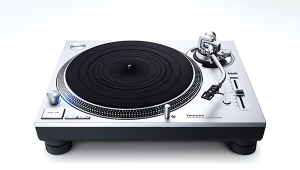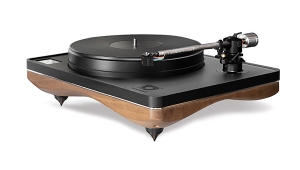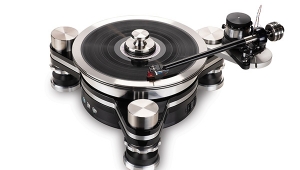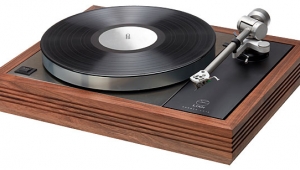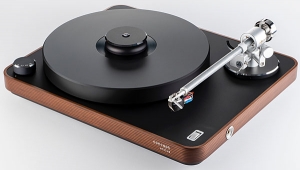| Columns Retired Columns & Blogs |
SOTA Star Sapphire turntable Anthony H. Cordesman, May 1986
Anthony H. Cordesman wrote about the Star Sapphire in May 1986 (Vol.9 No.4):
The Improved SOTA Star Sapphire ($1600) may well be the last turntable you will ever buy?
The competition at the top has been pretty stiff in recent years. The Entec Granite ($6000), Goldmund Studio ($2900), Goldmund Reference ($14,900), Micro Seiki SX-5000 II ($5000), Oracle Delphi Mk.II ($1250), and VPI HW-19 Mark II ($885) are all superb turntables. Any of them would grace any system to the point where even the most demanding audiophile (though not divinity) could live happily with the result for years.
Nevertheless, if I were going to invest in my last turntable, I would currently invest in the SOTA Star Sapphire with the acrylic Supermat ($1600), and the SOTA Electronic Flywheel ($300) or VPI Powerline Conditioner ($300).
Combining the SOTA Star Sapphire's vacuum record clamping with the new acrylic "Supermat" has produced a turntable which is more neutral on more records than any other turntable I've tried at any price. I must admit that I have to make this statement on the basis of listening to the top foreign competition—like the Goldmund and Micro Seiki—on other systems. Nevertheless, I think the sonic differences are clear. You can hear more musical detail and transparency, with less coloration and noise, using the Star Sapphire and an arm like the Eminent Technology Two, than with other turntables, even those costing over $10,000.
The key to the SOTA's success seems to be the combination of vacuum clamping with the kind of hard plastic surface/metal-filled turntable platter pioneered by Goldmund, and now used in different combinations by both SOTA and VPI. The result is superior to all the competition in its ability to couple the largest number of records to the platter in a manner that produces the best possible combination of detail, transparency, freedom from noise, and natural musicality. The damping of the record seems nearly perfect, without any loss of life and dynamics, or any noticeable addition of coloration—problems that emerge to a slight degree in the regular Star Sapphire, and to a significant degree in the regular SOTA Sapphire without its Supermat and an appropriate clamp.
The vacuum clamping also seems to make a small but significant difference in terms of the geometry presented to the tonearm. Turntables without effective clamping are much more prone to at least mild record warp, which drives the tonearm up and down as it tracks the record—a hill and dale effect which adds unnecessary distortion with all cartridges. While the VPI, Oracle, and Goldmund largely solve this problem with mechanical clamps, they do not solve it as well.
There is no change in the character of the sound from the outside to inside of the groove, as often happens on turntables—like the Linn and AR—which lack an effective clamping system. Further, the SOTA Star Sapphire does a better job of keeping the record flat all over its surface. The VPI, Oracle, and Goldmund never permit you to set up as consistent a cartridge azimuth adjustment with as wide a range of records as does the SOTA Star Sapphire; clampless designs like the Linn and Pink Triangle don't even come close. With today's stylus designs and straightline tonearms, this superior geometry seems to result in notably more transparent sound.
The noise floor and dynamics of the SOTA Star Sapphire and acrylic Supermat are very good without any accessions, but adding the SOTA Electronic Flywheel or VPI Powerline Conditioner produces the best noise floor and long-term speed stability I have heard, except for a few custom-made models not available to the public. The difference between the Star Sapphire and the other contenders is small, but nevertheless noticeable after prolonged listening; it is worth considering for those who seek the very best.
As for overall sound character, the SOTA Star Sapphire and VPI HW-19 II both have excellent bass, equal to the best high-mass Japanese designs and to the most expensive Goldmunds. The VPI may be slightly better than the SOTA in terms of its resolution of deep bass, but the SOTA Star Sapphire experiences no loss of low bass, as do the Oracle Delphi and virtually all British suspension turntables.
The SOTA Star Sapphire and acrylic Supermat combination suffers no loss or exaggeration of detail or timbre in the critical transition area from midbass to midrange. The sweet, open midrange is slightly less dynamic or "live" than that of the VPI HW-19, but the difference is small, and the issue of accuracy is one no one can honestly resolve; both seem equally convincing. This corrects a chronic weakness in the SOTA Sapphire and regular Star Sapphire.
The Star Sapphire/acrylic Supermat combination provides clean, flat, detailed upper midrange and treble without any hardness or "etching" of low-level harmonics. The result is worth hearing if you have criticized other SOTAs in this regard. Some audiophiles may find the resulting upper octave balance a bit "mid-hall," but few are likely to criticize it. The result is well-suited to most records and cartridges, and still seems to preserve timbral accuracy (at least to the extent that you can judge by comparing the turntable to the same performance on CD).
The speed adjustments and ergonomics are also good—with the exception of a low and clumsy dustcover which is incompatible with many of the best tonearms. The vacuum pump is very quiet and acceptably styled. The cabinet work can be very good, although there is some sample-to-sample variation. Check your sample for quality before buying it.
Further, the various SOTA models remain freer of acoustic breakthrough problems under real-world installation conditions than any other turntables I know of—at any price. This is critical in many listening rooms, particularly where the turntable must be in the same room as full-range speakers. The VPI, Oracles, and Goldmunds are also quite good in terms of acoustic breakthrough, but never quite as good in difficult rooms. Most British turntables—including the Linn and Pink Triangle—simply don't come close.
Most of these advantages are retained even if you do not buy the VPI Powerline Conditioner or the SOTA Electronic Flywheel. Either accessory does, however, make a significant difference. This difference is hard to explain in terms of measurement, and only shows up after prolonged listening, but it is reflected in the superior apparent signal-to-noise ratio I mentioned earlier, and in what I can only call long term "stability." The improvement is not simply a matter of wow and flutter, speed variation, or pitch—at least to the extent ordinary test gear reveals. It is rather a feeling of almost subconscious credibility: the music seems to emerge without a degree of low-level mechanical change that's otherwise present. For some reason, record surface noise is also reduced; I don't know why, but it is.
As for the choice between the SOTA Electronic Flywheel and VPI Powerline Conditioner: I prefer the VPI because it produces virtually the same sonic effect as the Electronic Flywheel, but is a lot smaller and can be used with most other turntables, and some CD players. While some audiophiles may like two large boxes worth of outboard equipment (the pump and electronic flywheel), I don't. If you want an all-SOTA approach, however, rest assured that only the tweakiest of audiophiles will hear the difference. Don't use both devices; it improves nothing. If you already own one, there is no reason to buy the other.
I only recommend the SOTA in its current version with the acrylic Supermat. The older SOTA Star Sapphire simply did not have the same neutrality. It seemed to lose upper octave detail and overdamp the record; too much of the music's life is lost. The regular SOTA Sapphire now shows its age. It is still a very good turntable, but the warmth in the upper bass and lower midrange, and loss of air and life in the highs, are significant. The VPI HW-19 II is superior to both the SOTA Sapphire and Star Sapphire without its Supermat. Many other turntables now make up for their inferior low bass and vulnerability to acoustic breakthrough by providing linearity, air, and dynamics superior to the "regular" SOTAs.
Adding the regular acrylic Supermat ($135) and Reflex Clamp ($95) to the SOTA Sapphire makes a major improvement, but also raises the price to about $1130, and the VPI HW-19 II still provides slightly more linearity over the entire frequency range and slightly more realistic dynamic contrasts. Fortunately, present owners of the SOTA Sapphire can deal with this problem, although at a price: they can convert any Sapphire to vacuum clamping for $600.
And Now for the Gentle Art of Prophecy
I can't tell you whether another manufacturer will come out with a better turntable tomorrow. I can tell you, however, that all three of the products that are the focus of this review—The Orcale Delphi, the SOTA Star Sapphire, and the VPI HW-19— outperform any of their British rivals that I have yet heard, as well as the Japanese competition that has come my way. I feel safe in predicting that each will produce many years of excellent performance—and that any serious audiophile will still need a good turntable in 1996, regardless of what happens with CD, DAT, PACMAN, or what have you. Serious music collectors and listeners will need access to records for many years to come.
If you've gotten over the initial shock of CD, it may well be time for a SOTA Star Sapphire and acrylic Supermat, a VPI HW-19 II, a Delphi Oracle II—or an Entec Granite or Goldmund. After all, CD players lack sport. You plug them in and have nothing to do! A beautiful turntable is a toy forever!
Notes
I should note that while it has been easy for me to obtain the latest models of most turntables, I have not had the loan of the Granite, the latest Goldmunds, or of the most expensive Micro-Seiki to try in my own system. My comments on them are based on listening to these units in friends' systems. Nor have I tried the Michell Gyrodec, or the Thorens "super" turntable, to the point where I could comment. This short list deliberately excludes the AR ET-101, Denons, Linn Valhalla, Missions, Nakamichi Dragon CT, Pink Triangle, Revox, Systemdeks, and Technics SP10 Mark II and Mark III; I don't think they belong in this category, regardless of price.
Sensitivity to speed variations varies sharply from person to person. I would not know perfect pitch if it crawled out of the La Brea Tar Pits, but slight shifts in cassette and record-player speed can drive me up the wall; some gear sounds notably better over time than others, and it doesn't necessarily show up that way on the measurements. Fortunately, most people recognize such problems by lack of long-term listening fatigue. Perfect pitch is an utter curse for those who take it seriously. I have one such friend who also happens to be a diplomat. He spends a good part of his social life cringing at most of the live music provided at formal dinner parties.
Making Your Decision to Buy
I have not heard all of the world's turntables, and other manufacturers constantly improve their products. I'd listen to the latest Entec Granite and Goldmunds before I made my own choice. You should regard my comments strictly as a guide for your own auditioning.
I would also stress that you should never buy a turntable except as part of a carefully considered front-end "system." Always listen in depth to your preferred combination of turntable, cartridge, and arm before you buy in this price range. You should be able to hear your arm and cartridge with the turntable you're considering buying. This may take some time, but it's worth it: a dealer's arm and cartridge can sound different because of setup, and changes in cartridge and tonearm. You should, however, consider a new cartridge or tone arm if your dealer can clearly demonstrate its merits. You are, after all, in search of synergy, and an old arm or worn cartridge may make it impossible to audition anything fairly.
I also advise close inspection of the specific turntable you buy and insistence on a return or exchange privilege. The high-end turntable business is filled with products made in small production runs, and many involve hand finishing. Listen for audible wow and rumble, and check your unit at the dealer's to make sure you do not start out with problems in mechanics or finish.
I'd push hard for a home trial if your dealer is exceptionally tolerant. While acute wow and flutter, rumble, and speed stability problems will be apparent at the dealer, low-level problems often show up only after a week or so. It's rough on the dealer, but I'd generally insist on a swap of any turntable with a problem, not repair. It's difficult or even impossible to fix many of the minor sound problems in turntables without a whole new platter or bearing assembly; even then the result may not be as good as a factory fit.
As for setup and system integration, a further improvement in the bass is possible with virtually all turntables by replacing the standard feet with spiked feet or Tiptoes. These will "fix" the turntable firmly to cabinet or shelf. This seems to consistently improve the clarity and "life" of the bass and lower midrange.
The SOTA, VPI, and Delphi also work synergistically with the new air bearing arms. The Eminent Technology Two, for example, provided outstanding performance with all three turntables (there is a special mounting kit for the Oracle). In fact, I'd urge you to audition this combination. I've not had the opportunity to test the new SME or the latest Goldmund arms in my system, but the few people I know who've experimented have all felt the Eminent Technology to be at least as good, and $700 to $2200 cheaper.
More generally, tonearm choice is at least as important as turntable choice. The tonearm often has more immediate effect on sound quality than the relatively small sonic differences that emerge between turntables like the VPI, SOTA, and Oracle. A tonearm produces more shifts in the midrange in terms of speed, resonant coloration, and soundstage characteristics. Tonearm choice can also be critical in terms of bass performance—few tonearms can really reproduce the deep bass.
Make sure the cartridge you love will work well with the tonearm you love in the turntable you choose. Ironically, the best tonearm I know in terms of the ability to switch cartridges (the Dynavector 507 with the Grado or Audioquest plug-in heads and a top quality tonearm interconnect) will only work on the VPI. While it's a more minor point, the SOTA's dust cover will not clear many tonearms; the optional dust cover on the VPI ($40) will clear virtually all tonearms.
Most turntable designers are also beginning to discover that the tonearm mounting board material can make a surprising amount of difference. Wood and composites usually produce a damped, controlled sound with good bass and the impression of some loss in transients, dynamics, and life. Heavy plastic can give you more transient life, dynamics, and bass, but the VPI turntable is the only one I've found so far where the acrylic plate is better than the metal. Metal mounting plates tend to give you lots of life and bass energy but also a touch of hardness, resonance noise, and exaggerated dynamics. Mortite helps in some cases, but not all. The Oracle Delphi provides the benefits of a metal plate without added resonance or loss of bass control.
I've tried a lot of so-called isolation boards that fit under the turntable. Some help with lighter suspension turntables like the Linn or AR, but none helped consistently with these top-ranked turntables. Placement turned out to be far more important than special isolation boards.
The VPI, SOTAs, and Oracle have relatively low vulnerability to acoustic breakthrough, but I have heard slight improvements in transparency and bass by moving them a few inches further away from the wall or by shifting them over the surface of vibrating furniture. Placement in an area away from standing waves or high bass energy nodes will improve their sound more significantly.
- Log in or register to post comments
